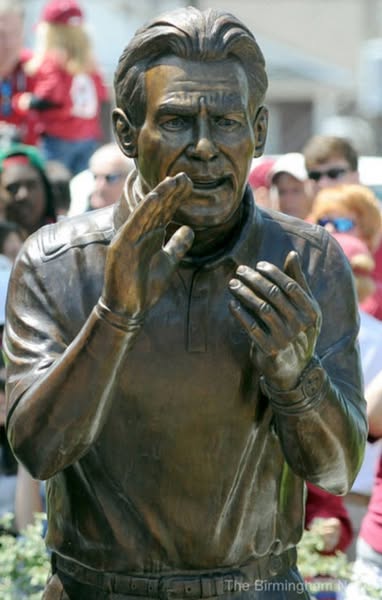Few names in the annals of college football evoke as much reverence, respect, and legendary status as Paul “Bear” Bryant. A towering figure both literally and figuratively, Bryant became a symbol of excellence and tenacity, particularly during his iconic 25-year tenure as the head coach of the Alabama Crimson Tide from 1958 to 1982. With a coaching career that spanned four decades, Bryant reshaped the landscape of college football and etched his name into sports history with a legacy that continues to influence the game today.
This 1500-word article delves into the life, career, and enduring legacy of Bear Bryant—the man who became synonymous with Alabama football and left an indelible mark on the sport.
Early Life and Playing Career
Born on September 11, 1913, in Moro Bottom, Arkansas, Paul William Bryant was the 11th of 12 children. His nickname “Bear” was famously earned after he agreed to wrestle a bear at a carnival as a teenager—an early display of the toughness and grit that would define his life. Bryant attended Fordyce High School in Arkansas, where he was a standout football player. He later enrolled at the University of Alabama in 1931, playing as an end for the Crimson Tide under Coach Frank Thomas.
As a player, Bryant was known more for his toughness than raw talent. He played through injuries and led by example, attributes that would become hallmarks of his coaching career. After graduating in 1936, Bryant entered the coaching world, initially as an assistant at Alabama, and later at Vanderbilt and Georgia.
Head Coaching Debut and Early Stops
Bryant’s head coaching career officially began in 1945 at the University of Maryland, where he led the team to a 6–2–1 record in his only season there. Despite his success, conflicts with administration led him to resign. He then took over at the University of Kentucky in 1946.
At Kentucky, Bryant transformed a mediocre football program into a competitive force. By 1950, he led the Wildcats to an 11–1 season, culminating in a Sugar Bowl victory over then-undefeated Oklahoma—a win that snapped the Sooners’ 31-game winning streak. Despite his success, he clashed with Kentucky’s administration and athletic department, especially with the basketball-first culture led by Adolph Rupp.
In 1954, Bryant accepted the head coaching position at Texas A&M University. His time there is best remembered for his brutal training camp in Junction, Texas, where he pushed players to their physical and mental limits. The “Junction Boys,” as they became known, formed the foundation of a tough-minded team that won the Southwest Conference title in 1956.
The Alabama Era Begins (1958)
In 1958, Bear Bryant returned to his alma mater as the head coach of Alabama, famously stating, “Mama called, and when Mama calls, you just have to come runnin’.” The program was in decline, but Bryant quickly turned things around. In just four seasons, he led Alabama to an undefeated national championship season in 1961.
Over the next two decades, Bryant would build a dynasty at Alabama. He coached the Crimson Tide to six national championships (1961, 1964, 1965, 1973, 1978, and 1979) and thirteen SEC championships. His teams were known for their physicality, discipline, and relentless desire to win.
The Philosophy and Persona
Bryant was more than a coach—he was a cultural icon in the South and a symbol of hard-nosed, blue-collar football. He often wore his trademark houndstooth hat and carried an aura of authority that few dared to challenge. His coaching philosophy emphasized toughness, preparation, and loyalty.
“It’s not the will to win that matters—everyone has that. It’s the will to prepare to win that matters,” he once said. That mindset translated to his players, many of whom would credit Bryant not only for their football success but for their growth as men.
Integration and Social Impact
In the midst of the Civil Rights Movement, Southern football remained largely segregated through the 1960s. While Bryant did not immediately integrate Alabama’s football program, he played a crucial behind-the-scenes role in preparing the university and the fanbase for integration.
In 1971, Bryant made a groundbreaking move by signing Wilbur Jackson, the first Black scholarship football player at Alabama. That same year, John Mitchell became the first Black player to take the field for the Tide. Bryant’s decision helped open the door for Black athletes in the SEC and reshaped the talent pool available to Southern football programs.
Record-Breaking Success
On November 28, 1981, Bryant became the winningest coach in college football history when he earned his 315th career victory, surpassing Amos Alonzo Stagg. He would finish his career with a record of 323–85–17, a win total that stood as the benchmark in college football until Joe Paterno and later Bobby Bowden surpassed it decades later.
Bryant coached 58 All-Americans, won three national Coach of the Year awards, and led Alabama to 24 consecutive bowl games. He was inducted into the College Football Hall of Fame in 1986.
The Final Season and Farewell
Bryant’s final season in 1982 ended with a Liberty Bowl victory over Illinois, his 323rd and last win. On December 29, 1982, just four weeks after his final game, Bear Bryant retired from coaching.
Less than a month later, on January 26, 1983, Bear Bryant died of a heart attack at the age of 69. The nation mourned, and in Alabama, the state practically shut down in his honor. Over 300,000 people paid their respects as his casket passed through Tuscaloosa. His passing was more than the loss of a coach—it was the end of an era.
The Enduring Legacy
Bear Bryant’s influence on college football remains as potent as ever. Bryant-Denny Stadium in Tuscaloosa bears his name, and his statue stands tall outside the stadium alongside other Alabama national championship coaches. Every Alabama coach since his departure has been measured against the towering standard he set.
His coaching tree is equally impressive. Dozens of former assistants and players became head coaches across college and professional football. He inspired generations of coaches, including legends like Gene Stallings, Howard Schnellenberger, and Jackie Sherrill.
Bryant’s emphasis on preparation, loyalty, and discipline helped lay the foundation for modern college football. He also demonstrated adaptability—transitioning from run-heavy offenses to the wishbone formation in the 1970s to maintain competitive dominance.
Cultural Impact and Popular Media
Bryant’s larger-than-life persona inspired books, documentaries, and even movies. The 1984 film The Bear, starring Gary Busey, dramatized Bryant’s life. Countless biographies, including Bear: The Hard Life and Good Times of Alabama’s Coach Bryant by Paul Hemphill, delve into his complicated yet revered legacy.
The phrase “Roll Tide” became a rallying cry not just for Alabama fans but as a representation of the toughness and tradition that Bryant championed. His image, particularly in the houndstooth hat and stern sideline pose, became iconic in American sports.
Criticism and Controversy
Though adored by millions, Bryant’s legacy is not without criticism. Some believe he should have moved faster to integrate his teams, especially as other programs were already doing so. Others argue that his tough-love methods and brutal practices wouldn’t be acceptable in today’s game.
Yet even critics acknowledge his impact. He coached in a different time—when the expectations and pressures were different, and the sport itself was undergoing massive change.



